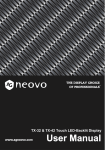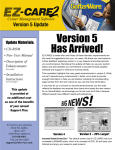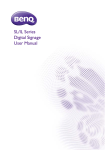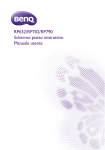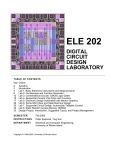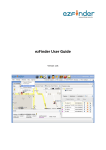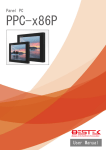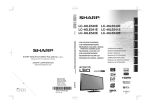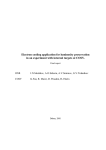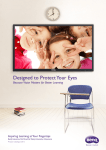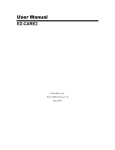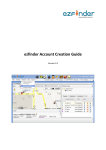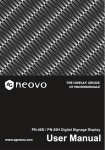Download RP840G User Manual
Transcript
RP840G Interactive Flat Panel User Manual Disclaimer BenQ Corporation makes no representations or warranties, either expressed or implied, with respect to the contents of this document. BenQ Corporation reserves the right to revise this publication and to make changes from time to time in the contents thereof without obligation to notify any person of such revision or changes. Copyright Copyright 2014 BenQ Corporation. All rights reserved. No part of this publication may be reproduced, transmitted, transcribed, stored in a retrieval system or translated into any language or computer language, in any form or by any means, electronic, mechanical, magnetic, optical, chemical, manual or otherwise, without the prior written permission of BenQ Corporation. Table of Contents i Table of Contents Safety warnings and precautions ...................................... 1 Important safety instructions............................................ 2 Notes on this display ...................................................................... 2 Notes on the LCD panel of this display..................................... 2 Safety notice for remote control................................................. 3 Battery safety notice ....................................................................... 3 BenQ ecoFACTS.............................................................................. 4 Package contents ................................................................. 5 Setting up the display .......................................................... 6 Mounting the display....................................................................... 6 Parts of the display and their functions .......................... 8 Front panel ....................................................................................... 8 Input/output terminals.................................................................... 9 Remote control............................................................................. 10 Using the remote control ........................................................... 12 Connection ......................................................................... 14 Connecting power........................................................................ 20 Using the touch screen..................................................... 21 Important instructions for using the touch screen............... 25 Menu operations................................................................ 26 One touch menu operation ....................................................... Setting menu .................................................................................. More settings................................................................................. Android system interface............................................................ 26 26 28 36 Product information.......................................................... 44 Specifications ................................................................................. 44 Dimensions .................................................................................... 46 Supported input signal resolution............................................. 47 Troubleshooting ................................................................. 49 1 Safety warnings and precautions Safety warnings and precautions The lightning flash with arrowhead symbol, within an equilateral triangle, is intended to alert the user to the presence of uninsulated "dangerous voltage" within the product's enclosure that may be of sufficient magnitude to constitute a risk of electric shock to persons. The exclamation point within an equilateral triangle is intended to alert the user to the presence of important operating and maintenance (servicing) instructions in the literature accompanying the appliance. THIS EQUIPMENT MUST BE GROUNDED To ensure safe operation, the three-pin plug must be inserted only into a standard three-pin power outlet which is effectively grounded through normal household wiring. Extension cords used with the equipment must have three cores and be correctly wired to provide connection to the ground. Wrongly wired extension cords are a major cause of fatalities. The fact that the equipment operates satisfactorily does not imply that the power outlet is grounded or that the installation is completely safe. For your safety, if you are in any doubt about the effective grounding of the power outlet, please consult a qualified electrician. • The mains plug of the power supply cord shall remain readily operable. The AC receptacle (mains socket outlet) shall be installed near the equipment and shall be easily accessible. To completely disconnect this equipment from the AC mains, disconnect the power cord plug from the AC receptacle. • Do not place this display on an uneven, sloping or unstable surface (such as a trolley) where it may fall and cause damage to itself or others. • Do not place this display near water, like a spa or pool, or in a position which will allow the splashing or spraying of water onto the display, like in front of an open window where rain water may enter. • Do not install this display in a confined space without proper ventilation and air circulation, such as in a closed cabinet. Allow proper space around the display for dissipating heat inside. Do not block any openings and vents on the display. Overheating may result in hazards and electric shock. • Installation of this display should only be performed by a qualified technician. Failure to install this display properly may cause injuries and damages to the personnels and the display itself. Check the installation regularly and maintain the display periodically to ensure the best working condition. • Use only the accessories approved or recommended by the manufacturer to mount this display. Using wrong or unsuitable accessories may cause the display to fall and result in serious personal injuries. Make sure that the surface and fixing points are strong enough to sustain the weight of the display. • To reduce the risk of electric shock, do not remove covers. No user serviceable parts inside. Refer servicing to qualified service personnel. • To prevent personal injuries, mounting the display or installing desktop stands is required before use. Important safety instructions 2 Important safety instructions 1. 2. 3. 4. 5. 6. 7. 8. 9. 10. 11. 12. 13. 14. Read these instructions. Keep these instructions. Heed all warnings. Follow all instructions. Do not use this apparatus near water. Clean only with dry cloth. Do not block any ventilation openings. Install in accordance with the manufacturer's instructions. Do not install near any heat sources such as radiators, heat registers, stoves, or other apparatus (including amplifiers) that produce heat. Do not defeat the safety purpose of the polarized or grounding-type plug. A polarized plug has two blades with one wider than the other. A grounding-type plug has two blades and a third grounding prong. The wide blade or the third prong are provided for your safety. If the provided plug does not fit into your outlet, consult an electrician for replacement of the obsolete outlet. Protect the power cord from being walked on or pinched particularly at plugs, convenience receptacles, and the point where they exit from the apparatus. Only use attachments/accessories specified by the manufacturer. Use only with the cart, stand, tripod, bracket, or table specified by the manufacturer, or sold with the apparatus. When a cart is used, use caution when moving the cart/apparatus combination to avoid injury from tip-over. Unplug this apparatus during lightning storms or when unused for long periods of time. Refer all servicing to qualified service personnel. Servicing is required when the apparatus has been damaged in any way, such as power-supply cord or plug is damaged, liquid has been spilled or objects have fallen into the apparatus, the apparatus has been exposed to rain or moisture, does not operate normally, or has been dropped. Notes on this display • This display weights more than 100 kilograms. Do not attempt to lift the display alone. • Make sure you have four or more people available to help lift or a flat cart to transport the display to its final location. • Keep the display horizontal as much as possible. • Clear a floor space before unpacking. Notes on the LCD panel of this display • The Liquid Crystal Display (LCD) panel of this display has a very thin protective layer of glass which is liable to marking or scratching, and cracking if struck or pressured. The liquid crystal substrate is also liable to damage under excessive force or extreme temperatures. Please handle with care. • The response time and brightness of the LCD panel may vary with the ambient temperature. 3 Important safety instructions • Avoid placing the display in direct sun or where direct sun or spot lighting will shine onto the LCD panel, as the heat may damage the panel and the external casing of the display, and the bright light will make viewing the display more difficult than necessary. • The LCD panel consists of individual pixels to display images and is manufactured according to the design specifications. While 99.9% of these pixels work normally, 0.01% of the pixels may remain constantly lit (in red, blue or green) or unlit. This is a technical limitation of the LCD technology and is not a defect. • LCD screens, like plasma (PDP) and conventional CRT (Cathode Ray Tube) screens, are also susceptible to 'screen burn-in' or 'image retention' which can be found on the screen as visible fixed lines and shades. To avoid such damage to the screen, avoid displaying still images (like On-Screen Display menus, TV station logos, fixed/inactive text or icons) for more than two hours. Change the aspect ratio from time to time. Fill the entire screen with the image and eliminate the black bars whenever possible. Avoid displaying images in 4:3 aspect ratio over a long period of time, otherwise there may be visible burn marks on the screen as two vertical lines. Note: Under certain circumstances, condensation may occur on the inner side of the cover glass, it's a natural phenomenon and will not affect the operation of the display. This condensation will usually disappear after around 2 hours of normal operation. Safety notice for remote control • Do not put the remote control in the direct heat, humidity, and avoid fire. • Do not drop the remote control. • Do not expose the remote control to water or moisture. Failure to do so could result in malfunction. • Confirm there is no object between the remote control and the remote sensor of the product. • When the remote control will not be used for an extended period, remove the batteries. Battery safety notice The use of the wrong type of batteries may cause chemical leaks or explosion. Please note the following: • Always ensure that the batteries are inserted with the positive and negative terminals in the correct direction as shown in the battery compartment. • Different types of batteries have different characteristics. Do not mix different types. • Do not mix old and new batteries. Mixing old and new batteries will shorten battery life or cause chemical leaks from the old batteries. • When batteries fail to function, replace them immediately. • Chemicals which leak from batteries may cause skin irritation. If any chemical matter seeps out of the batteries, wipe it up immediately using a dry cloth, and replace the batteries as soon as possible. • Due to varying storage conditions, the battery life for the batteries included with your product may be shortened. Replace them within 3 months or as soon as you can after initial use. • There may be local restrictions on the disposal or recycling of batteries. Consult your local regulations or waste disposal provider. Important safety instructions 4 BenQ ecoFACTS BenQ has been dedicated to the design and development of greener product as part of its aspiration to realize the ideal of the "Bringing Enjoyment 'N Quality to Life" corporate vision with the ultimate goal to achieve a low-carbon society. Besides meeting international regulatory requirement and standards pertaining to environmental management, BenQ has spared no efforts in pushing our initiatives further to incorporate life cycle design in the aspects of material selection, manufacturing, packaging, transportation, using and disposal of the products. BenQ ecoFACTS label lists key ecofriendly design highlights of each product, hoping to ensure that consumers make informed green choices at purchase. Check out BenQ's CSR Website at http:// csr.BenQ.com/ for more details on BenQ's environmental commitments and achievements. 5 Package contents Package contents Open the sales package and check the contents. If any item is missing or damaged, please contact your dealer immediately. LCD display Power cord x 4 D-Sub (15-pin) cable x 1 Audio interface cable Quick start guide USB cable x 1 AAA battery x 2 Touch pen x 2 Remote control Wall mount • The type of power cord supplied may differ from that illustrated depending on your region of purchase. • Before discarding the package, check that you haven't left any accessories inside the box. • Dispose of packaging materials wisely. You can recycle the cardboard carton. Consider storing the package (if possible) for future transport of the display. • Do not leave plastic bags within reach of young children or babies. Setting up the display Setting up the display Mounting the display You can install the display on a vertical surface with a suitable wall mounting bracket or on a horizontal surface with the optional desktop stands. Please pay attention to the following notes during installation: • This display should be installed by at least two adult persons. Attempting to install this display by only one person may result in danger and injuries. • Refer the installation to qualified technicians. Improper installation may cause the display to fall or malfunction. Installing the display on a wall 1. Place a clean, dry and lint-free cloth on a flat, horizontal and object-free surface. Make sure that the size of the cloth is larger than the display. 2. Gently lay the display on the cloth with the LCD screen facing down. 3. Remove the desktop stands from the display if installed. *Screw type: M8 4. Identify the wall mounting screw holes on the back of the display as shown in the illustration. 5. Install the wall mounting bracket on the display and attach the display to the wall according to the mounting bracket’s instructions. The length of the screw should exceed the thickness of the wall mounting bracket by at least 10 mm. Make sure that all screws are tightened and secured properly. (Recommended torque: 470 635N•cm). The mounting means should be strong enough to bear the weight of the display. Thickness of the wall mounting bracket LCD display 10 mm (0.39") 6 7 Setting up the display • To maintain proper ventilation, keep at least 10 mm of clear space from the back cover of the display to the wall. • Please consult a professional technician for wall mount installations. The manufacturer accepts no liability for installations not performed by a professional technician. 10mm (0.39") Parts of the display and their functions 8 Parts of the display and their functions Front panel No. Name Description 1 Power Tap to enter energy saving mode. Press and hold for 2 seconds or more to power off. 2 Home Press to back to main screen. 3 Return Press to return to previous level of menu. 4 Menu Press to enter function menu. 5 Volume Down Press to decrease volume. 6 Volume Up Press to increase volume. 7 Remote Control Signal Receiver Receives remote control signals. Do not obstruct the receiver. 9 Parts of the display and their functions Input/output terminals HDMI4(4K2K) HDMI4(4K2K) No. Name Description Connects USB devices such as USB keyboards, USB mice, and USB flash drives. High-definition multimedia interface signal input. Connect to PC with an HDMI output, a set-top-box, or other video devices capable of realizing touch function. • HDMI 3 realizes MHL function. • HDMI 4 realizes 4K2K resolution. 1 USB 2 HDMI IN 3 VGA OUT Connects to display devices with a VGA input. 4 AUDIO IN External computer audio input. 5 VGA IN External computer image input. 6 TOUCH External computer touch signal input. Default touch function is available under internal computer, when connecting external computer, besides connecting external computer VGA and audio signals, external computer's USB port needs to be connected to the equipment. Under the condition that driver is installed, external computer can be touch controlled through the equipment (touch function is effective in PC, VGA and HDMI channel by default) 7 AV IN Composite video and audio input. 8 COAX OUT Coaxial output. 9 RS232 Serial interface, used for mutual transfer of data between devices. 10 EARPHONE Connected to device with headphone input function. 11 WAN WAN interface, connecting RJ45 terminals. (This network port is only used for Android system.) 12 AC IN AC power input, connecting AC power supply. 13 POWER SWITCH Power switch, to open and shut down AC power supply. Parts of the display and their functions Remote control 10 3 Built-in computer Windows key. 4 Space Built-in computer space key. 5 Alt+Tab Built-in computer Alt+Tab key. 6 Alt+F4 Built-in computer program window close button. 7 Numeric buttons Performs as numeric buttons. 8 Display Shows the current input source and information. 9 TV channel return key. 10 INPUT Selects the input source. 11 HOME Andriod system main screen button. 12 MENU Opens or closes the OSD menu. 1 13 Turns the display on or off. Red button TV channel function button. 2 Turns on or off the mute function. 15 Green button TV channel function button. 15 Yellow button TV channel function button. 16 Blue button TV channel function button. Built-in computer is not available on RP840G. 11 Parts of the display and their functions Direction key. Press for right selection. 21 Direction key. Press for downward selection. 22 23 ENTER Confirms your selection or save changes. 24 Quickly start writing application (EZWrite). Select writing pen quickly if the application is started. 25 Back Return key. 26 PgUp Built-in computer page (previous page). 27 PgDn Built-in computer page (next page). 28 CH+/CH- Channel switch key. 29 VOL+/VOL- Volume switch key. 17 One key for blank screen. 30 F1 - F12 Built-in computer F1 - F12 function keys. 18 Backspace key. 19 Direction key. Press for upward selection. 20 Direction key. Press for left selection. • All buttons related to computer are regarded as disabled in case of no built-in computer. • TV functions are not available. Parts of the display and their functions Using the remote control Installing remote control batteries 1. Open the remote control battery compartment cover. 2. Insert the supplied batteries ensuring that the positive and negative marked battery terminals match the (+) and (-) marks in the battery compartment. The supplied batteries are provided for your convenience so that you can operate the display straight away. You should replace them as soon as possible. 3. Refit the battery compartment cover. 12 13 Parts of the display and their functions Remote control usage tips • Point and aim the top front of the remote control directly at the display’s remote control sensor window when you press the buttons. • Do not let the remote control become wet or place it in humid environments (like bathrooms). • If the display’s remote control sensor window is exposed to direct sunlight or strong light, the remote control may not operate properly. In this situation, change the light source, readjust the angle of the display or operate the remote control from a location closer to display’s remote control sensor window. Connection 14 Connection Connecting the VGA input 1. Connect the VGA IN jack on the display to the VGA output jack on a computer using a D-Sub (15-pin) cable. 2. Connect the computer’s audio output jack to the AUDIO IN jack on the display with a suitable audio cable. 3. To view images from this input, press the INPUT button on the remote control to switch to respective input source. Connecting the touch module Connect the TOUCH (type B) jack on the display to the USB port of a computer using the supplied USB cable. The touch module of the display supports easy Plug-and-Play operation. There is no need to install additional drivers on the computer. D-Sub (15-pin) cable USB cable Audio cable Computer • Avoid blocking the touch screen frame (where sensors are located) when initiating the touch module. • It is highly recommended that you connect the display to the PC or laptop directly. Avoid connecting the display to a face plate device which may cause failures in touch operations. • If any ghost image occurs, please try to un-plug and then re-plug all USB cables. If the failure image still exists, use another USB type B to A cable. • TOUCH must be used with HDMI or VGA IN. 15 Connection Connecting the digital inputs 1. Connect the HDMI output jack of a computer or A/V device (such as a VCR or DVD player) to the HDMI input jack on the display using an HDMI cable. 2. To view images from this input, press the INPUT button on the remote control to switch to respective input source. HDMI4(4K2K) (MHL) HDMI cable DVD player The applicable cable is not supplied and should be purchased separately. Connection 16 Connecting the AV inputs 1. Connect the AV IN jack on the display to the output jack on an A/V device (such as a VCR) using an appropriate video cable. 2. Connect the VCR’s audio output jacks to the AV IN jacks on the display using a suitable audio cable. 3. To view images from this input, press the INPUT button on the remote control to switch to respective input source. Video Game Console DVD player Camcorder AV cable VCR Set Top Box Satellite Receiver The applicable cable is not supplied and should be purchased separately. 17 Connection Connecting the coaxial output To use coaxial out for acoustic applications: 1. Use coaxial cable to connect via COAX OUT to your audio equipment. 2. Plug in power cord, and switch power on. Coaxial cable drive Audio equipment The applicable cable is not supplied and should be purchased separately. Connection 18 Connecting the video output For computer: 1. Use D-Sub cable and audio cable to connect from VGA OUT and EARPHONE to the respective jacks of the devices. 2. Plug in power cord, and switch power on. 3. Press on the remote control to turn on the display. Press INPUT to switch to PC port. Set internal computer as VGA output or multi-screen display. Audio cable D-Sub (15-pin) cable 19 Connection Connecting to serial port Directly connect the computer to RS232 ports on the input/output terminals. Serial cable Computer • The applicable cable is not supplied and should be purchased separately. • This connection is applicable to straight-through serial cables only. • After using serial port line to connect central control equipment and machine, certain function of the machine can be controlled via central control equipment, such as: machine on/off, and adjustment of sound volume, etc. Connection 20 Connecting power Plug one end of the power cord into the Power jack on the display and the other end into an appropriate power outlet (if the outlet is switched, turn on the switch). • The supplied power cord is suitable for use with 100-240V AC power only. • The power cord and outlet illustrated may differ from the ones used in your region. • Only use an appropriate power cord for your region. Never use a power cord which appears damaged or frayed, or change the plug type on the power cord. • Be aware of the power loading when you use extension cords or multiple outlet power boards. • There are no user serviceable parts in this display. Never unscrew or remove any covers. There are dangerous voltages inside the display. Turn off the power and unplug the power cord if you intend to move the display. 21 Using the touch screen Using the touch screen You can use the optical touch screen to control your operating system. The touch screen can emulate basic mouse functions and supports multi-touch functions for Windows 7/ 8*. The following table shows a list of gestures you can use on the touch screen. • Ensure that you have installed the USB cable on the display to a computer. • *Multi-touch functions are only supported by Windows 8, Windows 7 - Home Premium, Professional, Enterprise and Ultimate versions. For Windows XP, Windows Vista and Windows 7 - Starter and Home Basic versions, multi-touch is not supported. • Windows is a registered trademark of Microsoft Corporation in the United States and other countries. OS functions Gesture actions For Windows XP, Windows Vista and Windows 7 Tap the screen once. Click Tap the screen twice. Double-click 1. Press on the target. 2. Hold and wait for a blue ring to appear. 3. Release your finger. Right-click Drag one finger left or right. Drag Using the touch screen OS functions Gesture actions For Windows Vista and Windows 7 Drag one finger left or right. Selection Quickly drag your finger (Flick) in a desired direction. Pan up / Pan down / Back / Forward Multi-touch functions For Windows 7 - Home Premium, Professional, Enterprise and Ultimate versions 1. Press on the target. 2. Tap the screen with another finger. 3. Release the second finger. Right-click Drag one or two fingers up or down. Scrolling or Move two fingers apart or toward each other. Zoom 22 23 Using the touch screen OS functions Gesture actions • Move two fingers in opposing directions. • Use one finger to pivot around another. Supported by specific applications Tap two fingers simultaneously. The target should be the midpoint between the fingers. Supported by specific applications For Windows XP, Windows Vista and Windows 7 Press and hold for 4 seconds. Wakeup from Windows sleep mode (S3) Gesture Description For Windows 8 Press and hold to learn This touch interaction causes detailed information or teaching visuals (for example, a tooltip or context menu) to be displayed without a commitment to an action. Anything displayed this way should not prevent users from panning if they begin sliding their finger. Tap for primary action Tapping on an element invokes its primary action, for instance launching an application or executing a command. Using the touch screen Gesture 24 Description Slide to pan Slide is primarily used for panning interactions but can also be used for moving, drawing or writing. Slide can also be used to target small, densely packed elements by scrubbing (sliding the finger over related objects such as radio buttons). Swipe to select, command, and move Sliding the finger a short distance, perpendicular to the panning direction, selects objects in a list or grid (ListView and GridLayout controls). Display the AppBar with relevant commands when objects are selected. Pinch and stretch to zoom While the pinch and stretch gestures are commonly used for resizing, they also enable jumping to the beginning, end, or anywhere within content with Semantic Zoom. A SemanticZoom control provides a zoomed out view for showing groups of items and quick ways to dive back into them. Turn to rotate Rotating with two or more fingers causes an object to rotate. 25 Using the touch screen Important instructions for using the touch screen Please clean the frame when there is sign of malfunction on the touch screen. • Before you clean the screen, make sure the display is turned off, and unplug the power cord. • Remove dust or dirt from the screen and the infrared plastic filter periodically. It is suggested using a small amount of alcohol to clean the infrared plastic filter. • To avoid damage to the screen, never use any type of abrasive materials to wipe the screen. • Use a neutral detergent to clean the touch screen. Avoid using detergents with erosive substance, such as banana oil or ammonia. • Moisten a clean soft, lint-free cloth with a neutral detergent and then clean the touch screen. • Do not spray a detergent on the screen surface or the body directly. It may result in a short circuit to the touch screen. • Keep the touch screen out of direct sunlight or spotlights. Menu operations 26 Menu operations One touch menu operation At the bottom middle position of the screen as the starting point, use a touch pen to drag toward center position of the screen, as shown below, to enter the menu. Setting menu Input setting Press INPUT on the remote control or use a touch pen dragging from the bottom middle to the center of the screen to enter attribute menu. Input Light Volume More AV • Press /// on the remote control or use a touch pen to select a desired input source and press ENTER on the remote control or directly click with the touch pen to confirm. • Press BACK on the remote control or click blank area outside menu with the touch pen to exit menu. 27 Menu operations Brightness setting Press INPUT on the remote control or use a touch pen dragging from the bottom middle to the center of the screen to enter attribute menu. Input Light Volume More Backlight • Press on the remote control or directly click Light icon with touch pen to enter brightness setting menu. • Press / on the remote control or drag brightness adjustment progress bar with the touch pen to adjust brightness. • Press BACK button on the remote control or click blank area outside menu with the touch pen to exit menu. Volume setting Press INPUT button on the remote control or use a touch pen dragging from the bottom middle to the center of the screen to enter attribute menu. Input Light V Volume l More Volume • Press on the remote control or directly click Volume icon with touch pen to enter volume setting menu. • Press / on the remote control or drag volume adjustment progress bar with the touch pen to adjust volume. Menu operations 28 • Press MUTE on the remote control or directly click with the touch pen to enable or disable mute. • Press BACK on the remote control or click blank area outside menu with the touch pen to exit menu. More settings Press on the remote control or directly click More icon with touch pen to enter more settings. Android settings When the input source is set to Android, press INPUT on the remote control or use a touch pen dragging from the bottom middle to the center of the screen to enter setting menu. • Press /// on the remote control or use a touch pen to select each option and press ENTER on the remote control or directly click with the touch pen to confirm. • Press BACK on the remote control or click blank area outside menu with the touch pen to exit menu. Options Description Ethernet Checking To view current network status and network preferences of the display Sound To set acoustic preferences. Sound mode options are Standard, Movie, Classroom, Meeting, and Custom. Balance of sound output can be adjusted here. Display To set visual preferences on Font size and Wallpaper. Apps To view memory consumption of apps in Android. Language&input To set Language and Keyboard & Input Methods in Android. Backup&reset To restore factory settings to system in Android. Date&time To set date, time, and their formats in Android. About device To view system information in Android. 29 Menu operations The user applicable storage space varies from pre-installed apps and images occupancies at the total memory space. AV settings When the input source is set to AV, press MENU on the remote control or use a touch pen dragging from the bottom middle to the center of the screen to enter attribute menu. Screen attributes Tap for screen attributes. • Press /// on the remote control or use a touch pen to select each option and press ENTER on the remote control or directly click with the touch pen to confirm. • Press BACK on the remote control or click blank area outside menu with the touch pen to exit menu. Attribute Description Brightness Press/on the remote control or use a touch pen to drag icon to adjust brightness attribute. Press/on the remote control or use a touch pen to drag icon to adjust contrast attribute. Press/on the remote control or use a touch pen to drag icon to adjust hue attribute. Press/on the remote control or use a touch pen to drag icon to adjust sharpness attribute. Press/on the remote control or use a touch pen to adjust color temperature of image. Options are Cold, Classroom, and Standard. Contrast Hue Sharpness Color Temp. Menu operations 30 Picture in picture attributes Tap for picture in picture attributes. • Press /// on the remote control or use a touch pen to select each option and press ENTER on the remote control or directly click with the touch pen to confirm. • Press BACK on the remote control or click blank area outside menu with the touch pen to exit menu. Attribute Zoom Description Press/on the remote control and press ENTER or use a touch pen to click icon to adjust display ratio of image. 31 Menu operations HDMI settings When the input source is set to HDMI, press MENU on the remote control or use a touch pen dragging from the bottom middle to the center of the screen to enter attribute menu. Screen attributes Tap for screen attributes. • Press /// on the remote control or use a touch pen to select each option and press ENTER on the remote control or directly click with the touch pen to confirm. • Press BACK on the remote control or click blank area outside menu with the touch pen to exit menu. Attribute Description Brightness Press/on the remote control or use a touch pen to drag icon to adjust brightness of image. Press/on the remote control or use a touch pen to drag icon to adjust contrast of image. Press/on the remote control or use a touch pen to drag icon to adjust sharpness attribute. Press/on the remote control or use a touch pen to adjust color temperature of image. Options are Cold, Classroom, and Standard. Contrast Sharpness Color Temp. Menu operations 32 Picture in picture attributes Tap for picture in picture attributes. • Press /// on the remote control or use a touch pen to select each option and press ENTER on the remote control or directly click with the touch pen to confirm. • Press BACK on the remote control or click blank area outside menu with the touch pen to exit menu. Attribute Zoom Description Press/on the remote control and press ENTER or use a touch pen to click icon to adjust display ratio of image. 33 Menu operations VGA settings When the input source is set to VGA, press MENU on the remote control or use a touch pen dragging from the bottom middle to the center of the screen to enter attribute menu. Screen attributes Tap for screen attributes. • Press /// on the remote control or use a touch pen to select each option and press ENTER on the remote control or directly click with the touch pen to confirm. • Press BACK on the remote control or click blank area outside menu with the touch pen to exit menu. Attribute Description Brightness Press/on the remote control or use a touch pen to drag icon to adjust brightness of image. Press/on the remote control or use a touch pen to drag icon to adjust contrast of image. Press/on the remote control or use a touch pen to adjust color temperature of image. Options are Cold, Classroom, and Standard. Contrast Color Temp. Menu operations 34 Picture in picture attributes Tap for picture in picture attributes. HP Position i tփ i o〱 ≪sᒩ VP osition Position P hase Phase Clock 㕟᭴ 㕟 Zoom Z o o᭴m Auto Adjust • Press /// on the remote control or use a touch pen to select each option and press ENTER on the remote control or directly click with the touch pen to confirm. • Press BACK on the remote control or click blank area outside menu with the touch pen to exit menu. Attribute Description H Position Press/on the remote control or use a touch pen to drag icon to adjust horizontal position of image. Press/on the remote control or use a touch pen to drag icon to adjust vertical position of image. Press/on the remote control or use a touch pen to drag icon to adjust phase position of image. Press/on the remote control or use a touch pen to drag icon to adjust clock frequency of image. Press/on the remote control and press ENTER or use a touch pen to click icon to adjust display ratio of image. Press/on the remote control and press ENTER or use a touch pen to click icon to automatically adjust image. V Position Phase Clock Zoom Auto Adjust 35 Menu operations Annotation menu Under any input source, place two fingers with about 20~50 mm spacing on the screen for more than two seconds to enter the annotation menu as below. The remote control is not capable of notation operations. Icon Function Description Annotation menu Pop up sub-menu. Return Main interface Click to return to previous operation interface. Click to return to main interface of Android system. Annotation brush Click to make annotation in the picture. Click again to change brush color. EZWrite Click to enter writing application (EZWrite). This application supports up to 6 points simultaneous writing. Screen image will be saved automatically when exiting whiteboard software. Storage location: resource browse/ blackboard writing. Resource browse Click to open resources browse menu. Screenshot Close Click for screenshot of current annotation image. Screenshot storage location: resource browse/ blackboard writing. Click to close annotation menu. Menu operations 36 Android system interface Main interface • Press / on the remote control to select icons at the bottom and press ENTER to execute the program, or directly tap the icon with a touch pen. • Press HOME on the remote control or Home button at the bottom of front panel to return to the main interface. EZWrite EZWrite is a flat panel writing application that supports 6-point touch. Icon Function Menu Exit Description Click to pop up submenu (background change/save). Click to exit the writing application. 37 Menu operations Picture in picture Click to pop up picture in picture interface. Image import Click to import required images. Select Click to select writing symbols. Brush Cancel Click to write. Press 3 seconds or more to enter setting screen to set brush color and thickness. Click to erase writing symbols or drag a box selection to erase. Click to cancel the previous operation. Restore Click to restore the cancelled operation. Eraser Page Add page Reveal page number of the current picture. click to add a new page of writing image. Menu operations 38 EZFinder EZFinder helps to search for files in the memory and in external storage of Android system. 1. 3. 2. 4. Item Function 1 2 3 Storage device File type filter Menu/exit 4 5 6 5. 6. Description Click to pop up submenu (background change/save). Click to highlight the desired file type to display. Click with the touch pen to pop up menu options or exit file browsing. File arrangement Arrange files with icons or a list. File operation Perform operations such as select/delete/crate/copy/cut. Main display area Display files of corresponding type in memory card. Multimedia files such as images, audios, and videos can be played by directly tapping on the file icon. 39 Menu operations Image Select the image file you want to play and perform the functions as provided on the screen according to your needs Plying Setting animation effect playing interval ti.. Set Wallpaper Icon Function Close the current playback. Magnify the current image. Shrink the current image. Play the previous image. Play/pause the current playback. Play the next image. Counterclockwisely rotate the current image. Clockwisely rotate the current image. Set the animation effect and playing interval for images being played, and set the current image as the wallpaper. Supported image format (codec): • JPEG (base-line up to 15360 x 8704, progressive up to 1024 x 768, MPO up to 15360 x 8640) • PNG (non-interlace up to 9600 x 6400, interlace up to 1200 x 800) • BMP (up to 9600 x 6400) Menu operations Audio Select the audio file you want to play and perform the functions as provided on the screen according to your needs Icon Function Close the current playback. Play the previous audio. Play/pause the current playback. Play the next audio. Check audios in the playlist. Repeatedly play audios in the playlist. Repeatedly play a single audio in the playlist. Randomly play audios in the playlist. Supported video format (codec) up to 1080p resolution: • mp3 (MPEPG1/2 Layer 1: 32Kbps~448Kbps, MPEPG1/2 Layer 2: 8Kbps~384Kbps, MPEPG1/2 Layer 3: 8Kbps~320Kbps, 16KHz~48KHz sampling rate) • m4a/aac (ACC, HEACC free format, 8KHz~48KHz sampling rate) • wma/asf (WMA: 128Kbps~320Kbps, 8KHz~48KHz sampling rate / WMA Pro: <768Kbps, ~96KHz sampling rate) • ogg (OGG: ~48KHz sampling rate) 40 41 Menu operations Video Select the video file you want to play and perform the functions as provided on the screen according to your needs. Icon Function Close the current playback. Play the previous video. Fast rewind the current video. Play/pause the current playback. Fast forward the current video. Play the next video. Check videos in the playlist. Supported video format (codec) up to 1080p resolution: • 3gp (H.264) • avi (MPEG-2, MPEG-4 Xvid-SP, MPEG-4 Xvid-ASP, H.264, MJPEG) • mkv (MPEG-4, H.264) • mov (MPEG-4 SP, H.264 BP, H.264 MP) • mp4 (MPEG-4 SP, MPEG-4 ASP, H.264 BP, H.264 MP, H.264 HP) • mpg, mpeg (MPEG-2) • ts (MPEG-2, H.264 MP) Menu operations Browser At network connected state, click on browser icon to surf the Internet. Click on the symbol X in the upper left cornet to close it. loading... http://www.google.com/ PIP Click on PIP icon to pop up picture-in-picture interface. 4 1 2 3 Item 1 2 3 4 Description Picture-in-picture interface. Click to choose a input source in the list to be shown. Click for full screen. Click to exit picture-in-picture interface. Click with the touch pen to pop up the input source list. To use remote control for picture-in-picture operations: • press to pop up the input source list. • Press to enable the selection from the list. • Press / to select and press ENTER to confirm the selection. 42 43 Menu operations Setting Setting is the shortcut to setting menu. Refer to "Setting menu" for details. Apps Other than preset apps located at the bottom of the screen, additional apps will be placed in the same section and be displayed when App icon is clicked. Product information 44 Product information Specifications Item Backlight Panel size LCD panel 3840 x 2160 Brightness (cd/m2) (typical) 1600:1 8 10-bit IR Touch Resolution 32767 x 32767 10 points (varies from operating systems and applications) Accuracy +/- 2mm Touch Output USB x 1 Operating System Tempered glass Windows XP/Vista/7/CE, Mac OS X 10.6~10.9, Linux, Chrome OS (touch function varies from releases) AG coating, 80 Thickness 4mm Computer VGA (D-Sub 15-pin) x 3 Video Composite Video (3-in-1 connector) x 1, HDMI x 4 (1080P x 3, 4K2K x 1) Audio Line-in (3.5 mm jack) x 3 USB Control Type A; Type B RS-232C (D-Sub 9-pin) TV Tuner X Computer VGA (D-Sub 15-pin) x 1 Video X Audio Earphone (3.5 mm jack), COAX x 1 External speaker out (L/R) Audio 350 Technology Capacity Output 84" Native resolution (pixels) Panel Bit Input E-LED 0.4845 Response time (ms) (typical) Panel glass RP840G Pixel pitch (mm) Contrast (typical) Touch Specifications X Audio W (Amp) 10W x 2 Internal speaker O 45 Product information Supply Power 550W Consumption Standby < 0.5W Operating Temperature 0 - 40oC, 32 - 104oF Operating Humidity Environment Storage Temperature Storage Humidity Display Orientation Weight (kg) Mechanical Dimensions (W x H x D) (mm) Bezel Dimension - T/B/ L/R (mm) Feature 100 - 240V AC, 50/60 Hz Consumption Max. 10 - 90% (without condensation) -25 - 55oC, -13 - 131oF 10 - 95% (without condensation) Landscape 116 1978 x 1187 x 96 mm 40/62.5/40/40 Image setting O Source/Volume Control O Sharpness enhancement O Dimming control O 10-bit color processing O De-Interlacing / comb Filter O Customized Classroom Mode O Blank screen O Specifications and functions are subject to change without notice. Product information 46 Dimensions Unit: mm 47 Product information Supported input signal resolution Resolution 640 x 480 @ 60Hz 640 x 480 @ 67Hz 640 x 480 @ 72Hz 640 x 480 @ 75Hz 720 x 400 @ 70Hz 800 x 600 @ 60Hz 800 x 600 @ 75Hz 832 x 624 @ 75Hz 1024 x 768 @ 60Hz 1024 x 768 @ 75Hz 1152 x 870 @ 75Hz 1280 x 720 @ 60Hz 1280 x 768 @ 60Hz 1280 x 800 @ 60Hz RB 1280 x 800 @ 60Hz 1280 x 960 @ 60Hz 1280 x 1024 @ 60Hz 1360 x 768 @ 60Hz 1366 x 768 @ 60Hz 1400 x 1050 @ 60Hz 1600 x 1200 @ 60Hz 1680 x 1050 @ 60Hz RB 1600 x 1050 @ 60Hz 1920 x 1080 @ 50Hz 1920 x 1080 @ 60Hz 3480 x 2160 @ 30Hz NTSC-M NTSC-J PAL-BDGHI 576i (50Hz) 480i (60Hz) 480p (60Hz) Input source AV S-Video YPbPr VGA HDMI Product information 576p (50Hz) 720p (25Hz) 720p (30Hz) 720p (50Hz) 720p (60Hz) 1080i (50Hz) 1080i (60Hz) 1080p (24Hz) 1080p (25Hz) 1080p (30Hz) 1080p (24Psf) 1080p (25Psf) 1080p (50Hz) 1080p (60Hz) • : supported • Vacant: not supported • 3480 x 2160 @ 30Hz is available via HDMI 4. 48 49 Troubleshooting Troubleshooting Problem No picture No sound The computer input image looks strange The control panel buttons do not work Solution Check the following: • Is the display turned on? Check the power indicator of the display. • Is the signal source device turned on? Turn on the device and try again. • Are there any loose cable connections? Make sure that all cables are connected firmly. • Have you chosen an unsupported output resolution on the computer? Refer to Supported input signal resolution on page 47 to select a supported resolution and try again. • Have you chosen an unsupported output resolution on the DVD or Blu-ray disc player? Refer to Supported input signal resolution on page 47 to select a supported resolution and try again. Check the following: • Have you turned on the mute function on the display or the input source device? Turn off the mute function or increase the audio volume level and try again. • Are there any loose cable connections? Make sure that all cables are connected firmly. • Have you chosen an unsupported output resolution on the computer? Refer to Supported input signal resolution on page 47 to select a supported resolution and try again. • Use the Auto Adjust function (See AV settings on page 29) to let the display automatically optimize the display of computer image. • If the result of the Auto Adjust function is not satisfactory, use the Phase, Horizontal Pos. and Vertical Pos. functions to manually adjust the image. Have you locked the control panel buttons? Unlock the buttons and try again. Troubleshooting The remote control does • Have you locked the remote control function? Unlock the not work function and try again. • Check for incorrect battery orientation. • Check for dead batteries. • Check your distance and angle from the display. • Check whether remote control is properly being pointed at the display’s remote control sensor window. • Check for any obstacle between the remote control and the remote control sensor window. • Check that the remote control sensor window is not under strong fluorescent lighting, or in direct sunlight. • Check for any devices (computer or personal digital assistant, PDA) nearby that transmit infrared signals which may cause interference to signal transmission between the remote control and the display. Turn off the infrared function of these devices. Remote control failure 1. Check whether there are other objects between remote control and television remote control receiving window, thus leading to failure of remote control. 2. Check whether the battery electrode in the remote control is correct. 3. Check whether remote control needs to replace battery. Machine automatically 1. Whether set sleep or not. shutdown 2. Check whether there is sudden power outage. 3. Check whether there is no signal automatic shutdown. Signal out of range 1. Check whether display is set correctly. 2. Check whether resolution is the best resolution. 3. Adjust line and field synchronization in menu. 1. Select automatic correction in menu. 2. Adjust clock and phase position in menu. Image lack of color, color 1. Check whether VGA is not well connected or has qualis incorrect ity problem. 2. Adjust chromaticity and brightness or contrast in menu. Display format that is not 1. Select automatic correction in menu. supported. 2. Adjust clock and phase position in menu. Touch function invalid 1. Check whether touch driver is installed and started. 2. Check whether the size of article touched is comparable with finger. 1. Check whether driver is properly installed and make Touch positioning not correct correction. 2. Check whether touch pen is facing the screen. Background has vertical lines or streaks 50 51 Troubleshooting No picture and no sound 1. Check whether the machine is started state. 2. Check whether signal wire is well plugged, whether INPUT is corresponding to it. 3. If in internal computer mode, check whether internal computer is started. With horizontal or 1. Check whether signal wire is well connected. vertical stripes or image 2. Check whether other electronic equipment or power dithering tools are placed around the machine. No color, color is weak 1. Adjust chromaticity and brightness or contrast in menu. or image is weak 2. Check whether signal wire is well connected. With image but without 1. Check whether mute button is pressed for mute. sound 2. Press VOL. + / - to adjust volume. 3. Check whether audio line is connected correctly. Only one speaker has 1. Adjust sound balance in menu. sound 2. Check whether computer sound control panel only sets up one sound channel. 3. Check whether audio line is connected correctly. VGA output without Check whether connect external device with headphone sound cable. 11/25/14






















































